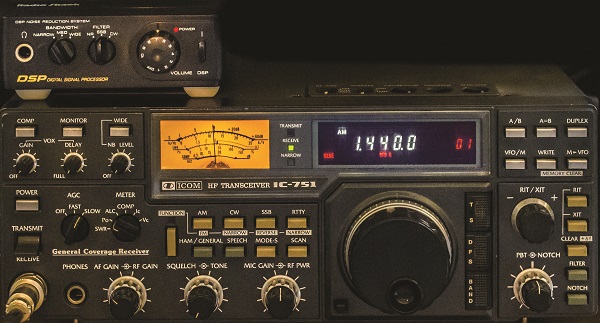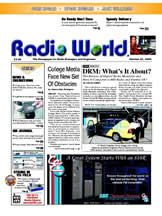 |
|
Fig. 1:
A communications
receiver tuned to
1440 kHz.
|
It reads like a Sherlock
Holmes mystery novel.
Tim Laes, corporate
director of engineering for
Midwest Communications,
received occasional listener
complaints about an unusual
noise heard on WNFL(AM) in
Green Bay, Wis., in November
and December 2013. WNFL is a
DA2 with 5 kW day and 500
watts night into three
towers on 1440 kHz.
However, AM radio
constantly battles noise
from fluorescent lights and
a hundred other sources, and
listeners often don't know
how to explain what they are
hearing, even when it is a
valid complaint.
Laes is a ham, call W9EE,
so he got off to a good
start in unraveling this
mystery. Hams often think
farther out of the box than
most people, and Laes
discussed the issue with
both local engineers and
other hams.
RANDOM DITS
The WNFL signal in Green
Bay was clean, so it was not
a studio or transmitter
problem. Then Laes
determined that most
listener complaints were
coming from south of town.
He lives north of Green Bay
but was able to hear the
interference, just barely,
using a ham receiver and
listening in the quiet
environment of his ham
shack. There it was,
something like Morse code at
about 15 words per minute,
but it didn�t decode into
letters and words. Instead,
it was a 1 kHz tone of
random dits and dahs, as
heard in the AM mode of his
receiver. That would be A2
modulated CW, which is
almost never used.
(Hear a one-minute sample
of the audio online at
http://mwpersons.com/sounds/12-16-13.mp3.)
Was it a pirate station,
deliberate interference or a
switching power supply gone
wild?
THE PLOT THICKENS
Driving tests confirmed
that the interference became
more audible as he traveled
south. There didn't seem to
be a definite source, and it
was nearly impossible to
track because KFIZ broadcast
on 1450 kHz in that area. It
causes normal
adjacent-channel modulation
interference, since it is
only 10 kHz up from WNFL. To
make matters worse, the
problem was only
intermittently heard on the
air.
In the spirit of
cooperation, broadcast
engineer Steve Konopka,
N9FOY, got involved. He
contacted Steve Brown,
W9APL, chief engineer for
Woodward Commutations in
Appleton. Konopka had two
radios going at once and
noticed that the Morse-like
sound seemed to happen in
cadence with programming on
1150 kHz WHBY, some 24 miles
at 171 degrees away from
WNFL. Konopka listened at
home while Brown briefly
shut off his 25 kW
transmitter on 1150 kHz and
then on his 1 kW 1570 kHz
station. Brown had recently
installed a new STL system;
it was interrupted as well.
All tests showed Woodward
was not the problem.
CASE SOLVED
Laes and Konopka decided
to do some tuning and
discovered the same tone was
audible 9 kHz above and
below 1450 kHz. They could
only hear the unwanted
signals by tuning receivers
up and down in frequency to
get the unknown signal
inside the 3 kHz bandwidth
of their receivers: KFIZ(AM),
in Fond Du Lac, Wis., is 1
kW day and night into a
single tower on 1450 kHz, a
local channel. It is some 53
miles down the road, at 206
degrees from WNFL.
Now Laes and Konopka
contacted Stu Muck, who does
engineering for KFIZ and was
in the process of replacing
large electrolytic
capacitors in the station's
Gates One transmitter.
 |
|
Fig. 2:
4.5 kHz Bandwidth on
NRSC Test
|
Muck noticed that the
transmitter's occupied
bandwidth was, as he said,
"starting to work its way
out of the NRSC mask."
Unfortunately, that repair
did not fix the 9 kHz
problem. The strange sound
went away when he
disconnected audio from the
input on the station's Orban
9100 audio processor. Muck
discovered the noise issue
was present only when
program audio was passing
through the processor.
Further analysis showed the
processor's number four card
was in oscillation at about
9 kHz, but only when there
was programming audio
present. Who'd ever heard of
that before?
Case solved.
NO COMPLAINTS
Remember how the 9 kHz
tone seemed to come and go
with modulation on WHBY?
Well, that is because KFIZ
was running the same
nationally syndicated talk
show as WHBY while some of
the listening tests were
being performed. Talk about
confusing the detectives
with a red herring!
So, the 9 kHz
oscillations on 1450 kHz
were heard as a Morse
code-like 1 kHz note on
receivers tuned to 1440 kHz,
because it was within the
receiver bandwidth when
tuned to 1440 kHz. There is
no nearby station on 1460
kHz to be interfered with,
otherwise that would have
been another clue.
Under current FCC rules,
any station could legally
transmit a 9 kHz tone at
full 100-percent modulation
and cause problems for RF
neighbors. Muck does not
have a record of how high
the unwanted 9 kHz
modulation was, but not much
is required for people to
take note when a steady
tone, or worse yet a Morse
code-esque tone, appears at
1 kHz, mixed with audio
intentionally broadcast.
No complaints were
received from KFIZ
listeners. Why? Well,
receiver manufacturers
reacted to customer noise
complaints years ago by
restricting audio bandwidth
in AM receivers to about 3
or 4 kHz. Very few AM
receivers today can
reproduce audio to the full
NRSC 10 kHz audio bandwidth.
SO MUCH FOR 10
kHz
I did frequency response
tests in my shop on a few AM
receivers. They were a
Sherwood RX4109 component
stereo, a Sony CFD-10 boom
box and a Bose AWR1-1W Wave
Radio.
The test setup featured
an AM stereo generator, set
to monaural, with an NRSC
pre-emphasis equalizer and
an NRSC low-pass filter
between an audio generator
and the exciter. No dynamic
audio processing occurred.
The exciter has a sample
transmitter output, which
produced enough signal for
receivers to hear it on the
bench. Receiver tone
controls were set for
standard response with no
bass or treble boost.
Test results were what we
expected, or at least
suspected. The surprising
part is that the receivers
had very similar response
curves averaging 2 dB down
at 3 kHz, 7 dB down at 4
kHz, 12 dB down at 5 kHz, 21
dB down at 7 kHz, and 32 dB
down at 9 kHz. I understand
that car radios are about
the same. So much for 10 kHz
audio!
On a side note, I
recently sold an Orban 9300
AM audio processor to a
client. Before it was
installed, I optioned the
software to allow only 4.5
kHz of audio bandwidth. The
station sounded loud, in
part because there was no
audio power transmitted and
wasted from 4.5 to 9.5 kHz.
No complaints, just happy
listeners who could hear
that talk station better.
Fig. 2 is a spectrum
analyzer display of 4.5 kHz
AM audio bandwidth.
Years ago, I remember
troubleshooting a pure 1 kHz
tone that listeners heard on
an AM station. The cause was
a second adjacent channel
(20 kHz away) AM station
that was rebroadcasting a
stereo FM station using a
monaural FM receiver. The 19
kHz stereo pilot from the FM
went right through the FM
receiver, audio processing,
transmitter, and out the
antenna. That was before
NRSC 9.5 kHz low-pass
filters were required. The
19 kHz tone was just 1 kHz
from the station being
interfered with and was
plainly audible to many
listeners in an area halfway
between the two station
locations.
I'd
like to make it clear that
the 9 kHz and 19 kHz signals
that caused 1 kHz tones in
receivers were not mixing
products between stations.
They were "signals on the
band" heard by
receivers.
Yes, some AM transmitters
are capable of modulating to
even 20 kHz, but the
receivers are not there
today to take advantage of
it. With increasing noise
levels on the AM band, I do
not advocate increasing AM
audio bandwidth. In my
opinion, we must make the
best of what we have to get
viable programming to
listeners. It makes perfect
sense.
Comment on this or
any article. Write to
radioworld@nbmedia.com.
Mark Persons, W0MH,
is a Certified Professional
Broadcast Engineer who has
more than 30 years�
experience. His website is
www.mwpersons.com.
Find past articles under the
Tech Tips tab at
radioworld.com.
You can also see this article online at
Radio World Magazine:
http://www.radioworld.com/article/what-is-that-irritating-sound/270401
|



